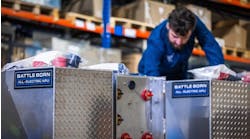The number of commercial truck drivers being placed out of service during the annual three-day Roadcheck safety blitz increased to its highest level in eight years-- with hours of service (HOS) violations continuing to be a major issue.
During the June 5-7 Roadcheck 2007 event, 7,708 Commercial Vehicle Safety Alliance (CVSA) and Federal Motor Carrier Safety Administration (FMCSA) personnel at 1,449 locations across North America conduced 62,370 truck and bus reviews – with 49,454 of them Level 1 inspections.
For the second straight year, the number of drivers placed out of service increased, rising to 6.2% in 2007, up from 5.6% in 2006 – the highest Roadcheck driver out of service rate since 1999, CVSA said. Even hazmat drivers were placed out of service at a higher rate – 3.5% in 2007 vs. 3% in 2006.
"These results are from our much higher focus on driver-related issues. The numbers definitely reflect that," Steve Keppler, CVSA's director of policy and programs, told FleetOwner. "We're also seeing much more targeted activity by motor carrier enforcement on high risk areas -- and we have a lot more data now on what problem areas we need to look at…the freight industry is rowing and our highways are getting more congested. That's one reason for trying to focus more efforts on weeding out the bad offenders."
The bulk of the drivers placed out of service this year – 65.9% – were done so for HOS violations, according to CVSA, up from 57.1% in 2006. HOS violations continue to be a problem area, reported CVSA, representing 4.9% of all inspections resulting in a driver being placed out of service – up from 4.5% in 2006, 3.5% in 2005 and 3.4% in 2004.
Falsification of records of duty status was second in line (11.4%), while the number of drivers discovered operating while disqualified this year was the highest in six years, comprising 3.6% of the total driver out-of-service violations. Drivers operating while suspended rose to 3.9%, up from 3.3% last year, while drug and alcohol out-of-service violations rose to 1.5% of the overall total, up from 0.9% in 2006.
On the flip side, the number of safety belt violations was down significantly this year – from 1,223 in 2006 to 829 in 2007. Safety belts were one of the focus areas during this year’s event and it seems to have paid off, said CVSA.
Vehicle-wise, more positive trends are emerging. CVSA said 78.5% of all vehicles passed inspection, with only 21.5% placed out of service compared to 21.7% in 2006. For hazmat haulers, 82.3% of vehicles passed, with 17.7% being placed out of service, compared to 18.2% last year. CVSA added that it issued 30,320 Level 1 inspection decals – 61.3% of all eligible inspections – to trucks that had no defects in the 13 critical inspection areas.
Brakes continue to dominate vehicle out-of-service defects, representing 54% of total vehicle defects, though that’s noticeably lower than the 56.6% rate logged in 2006, said CVSA. Defect rates did jump in distribution of lighting (14.1% in 2007, compared to 11.6% in 2006), load securement (10.4% from 8.6%) and tire/wheel issues (9.1% vs. 8.7%).
“In the last several years, our members have spent extra time and emphasis on training their inspectors in the areas of driver interviews, hours of service, cargo securement, and safety belt enforcement,” said CVSA executive director Stephen Campbell. “It is not a surprise to us that we are seeing these results. It means we are working smarter and are using our tools more effectively to identify and take action on those who are in need of our attention.”
“Safety on the nation’s highways and the safety of the motoring public continue to be the top priorities of the trucking industry,” said Gov. Bill Graves, president & CEO of the American Trucking Assns. (ATA), trucking’s largest lobbying group. “These figures do not mean that trucking is less safe, but that inspectors have improved their skill in selecting trucks and drivers for inspections.
“We support the removal of unsafe trucks from the road,” Graves added. “CVSA continues to become better at targeting those drivers and vehicles that should be out of operation.”


